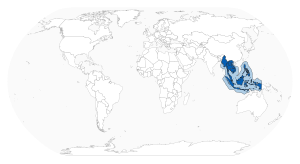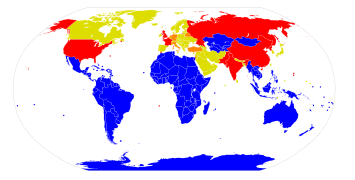Southeast Asian Nuclear-Weapon-Free Zone Treaty
| Treaty of Southeast Asia Nuclear Weapon-Free Zone | |
|---|---|
 Participation in the Southeast Asian Nuclear-Weapon-Free Zone Treaty includes all of ASEAN | |
| Type | nuclear disarmament |
| Signed | 15 December 1995 |
| Location | Bangkok |
| Effective | March 28, 1997 |
| Parties | 10 |
The Southeast Asian Nuclear-Weapon-Free Zone Treaty (SEANWFZ), or the Bangkok Treaty of 1995, is a nuclear weapons moratorium treaty between 10 Southeast Asian member-states under the auspices of the ASEAN: Brunei, Cambodia, Indonesia, Laos, Malaysia, Myanmar, Philippines, Singapore, Thailand, and Vietnam. It was opened for signature at the treaty conference in Bangkok, Thailand, on 15 December 1995 and it entered into force on March 28, 1997 and obliges its members not to develop, manufacture or otherwise acquire, possess or have control over nuclear weapons.
The Zone is the area comprising the territories of the states and their respective continental shelves and Exclusive Economic Zones (EEZ); "Territory" means the land territory, internal waters, territorial sea, archipelagic waters, the seabed and the sub-soil thereof and the airspace above them.
The treaty includes a protocol under which the five nuclear-weapon states recognized by the Treaty on the Non-Proliferation of Nuclear Weapons (NPT), namely China, the United States, France, Russia and the United Kingdom (who are also the five permanent members of the United Nations Security Council) undertake to respect the Treaty and do not contribute to a violation of it by State parties. None of the nuclear-weapon states have signed this protocol.
Background
[edit]
The groundwork of the establishment of the future Southeast Asian Nuclear-Weapon-Free Zone Treaty (SEANWFZ) was started on November 27, 1971, when the 5 original members of the Association of Southeast Asian Nations (ASEAN), Indonesia, Malaysia, Philippines, Singapore, and Thailand, met in Kuala Lumpur, Malaysia and signed the declaration on ASEAN's Zone of Peace, Freedom and Neutrality (ZOPFAN). One of the targets of ASEAN was also the establishment of SEANWFZ.
However, due to the political atmosphere at that time, including rivalries among the members and conflicts in the region and the Cold War, it was less feasible then to establish SEANWFZ. Thus the formal proposal for establishing a nuclear-free region was delayed until the 1990s, after the Cold War ended and conflicts were settled, and the member states renewed the denuclearization efforts. After conducting negotiations and finalizing the treaty for SEANWFZ by an ASEAN working group, the SEANWFZ treaty finally signed by the heads of government from 10 ASEAN member states in Bangkok on December 15, 1995. The treaty took effect on 28 March 1997[1] after all but one of the member states have ratified it. It became fully effective on 21 June 2001, after the Philippines ratified it, effectively banning all nuclear weapons in the region. In 2014 at the Meeting of the Commission for the Treaty on the SEANWFZ, the Ministers reviewed the progress on the implementation of the 2013-2017 Plan of Action to Strengthen the SEANWFZ Treaty, while reaffirming their commitment to preserve Southeast Asia as a Nuclear-Weapon Free Zone.[2]
Listing of parties
[edit]| State | Signed | Deposited |
| Dec 15, 1995 | Nov 22, 1996 | |
| Dec 15, 1995 | Jul 17, 1996 | |
| Dec 15, 1995 | Mar 27, 1997 | |
| Dec 15, 1995 | Apr 2, 1997 | |
| Dec 15, 1995 | Jul 16, 1996 | |
| Dec 15, 1995 | Oct 11, 1996 | |
| Dec 15, 1995 | Jun 21, 2001 | |
| Dec 15, 1995 | Mar 27, 1997 | |
| Dec 15, 1995 | Mar 20, 1997 | |
| Dec 15, 1995 | Nov 26, 1996 |
Protocol
[edit]The SEANWFZ treaty has a protocol that is open to signature by the five recognized nuclear-weapon states: China, France, Russia, the United Kingdom, and the United States. The protocol commits those states not to contribute to any violation of the treaty and not to use or threaten to use nuclear weapons within the zone.[4]
As of April 2015, none of the five has signed the SEANWFZ protocol,[5] but in November 2011 they agreed with ASEAN states on steps that would enable them to do so.[6]
| State | Signed | Deposited |
See also
[edit]- Nuclear disarmament
- Nuclear-weapon-free zone
- Treaty on the Non-Proliferation of Nuclear Weapons
- Zone of Peace, Freedom and Neutrality
- ASEAN
- Southeast Asia
References
[edit]- ^ "STATEMENT BY SINGAPORE AT THE THIRD PREPARATORY MEETING TO THE THIRD CONFERENCE OF STATES PARTIES AND SIGNATORIES TO TREATIES ESTABLISHING NUCLEAR WEAPON FREE ZONES AND MONGOLIA 2015, NEW YORK, 7 MAY 2014". Government of Singapore. Archived from the original on 26 November 2015. Retrieved 25 November 2015.
- ^ SINGAPORE, MINISTRY OF FOREIGN AFFAIRS. "MFA Press Statement: The 47th ASEAN Foreign Ministers' Meeting and related meetings, Nay Pyi Taw, Myanmar, 8 August 2014". Government of Singapore. Archived from the original on 26 November 2015. Retrieved 25 November 2015.
- ^ "Disarmament and Non-Proliferation". Government of Singapore. Archived from the original on 15 December 2015. Retrieved 25 November 2015.
- ^ "SOUTHEAST ASIA NUCLEAR-WEAPON-FREE ZONE TREATY (TREATY OF BANGKOK)" (PDF). Monterey Institute of International Studies. Archived from the original (PDF) on 7 April 2010. Retrieved 15 December 2011.
- ^ "STATEMENT BY AMBASSADOR KAREN TAN, PERMANENT REPRESENTATIVE OF SINGAPORE TO THE UNITED NATIONS, AT THE 2015 REVIEW CONFERENCE OF THE PARTIES TO THE TREATY ON THE NON-PROLIFERATION OF NUCLEAR WEAPONS, 29 APRIL 2015". Government of Singapore. Archived from the original on 22 October 2015. Retrieved 25 November 2015.
- ^ "Joint Statement of the 3rd ASEAN-U.S. Leaders' Meeting". Bali, Indonesia. 18 November 2011. Archived from the original on 4 June 2012. Retrieved 15 December 2011.
External links
[edit]- Treaties concluded in 1995
- Treaties entered into force in 1997
- Treaties of Brunei
- Treaties of Myanmar
- Treaties of Cambodia
- Treaties of Laos
- Treaties of Indonesia
- Treaties of Malaysia
- Treaties of Singapore
- Treaties of the Philippines
- Treaties of Thailand
- Treaties establishing nuclear-weapon-free zones
- Treaties of Vietnam
- ASEAN treaties
- Nuclear weapons governance
- 1995 in Thailand
